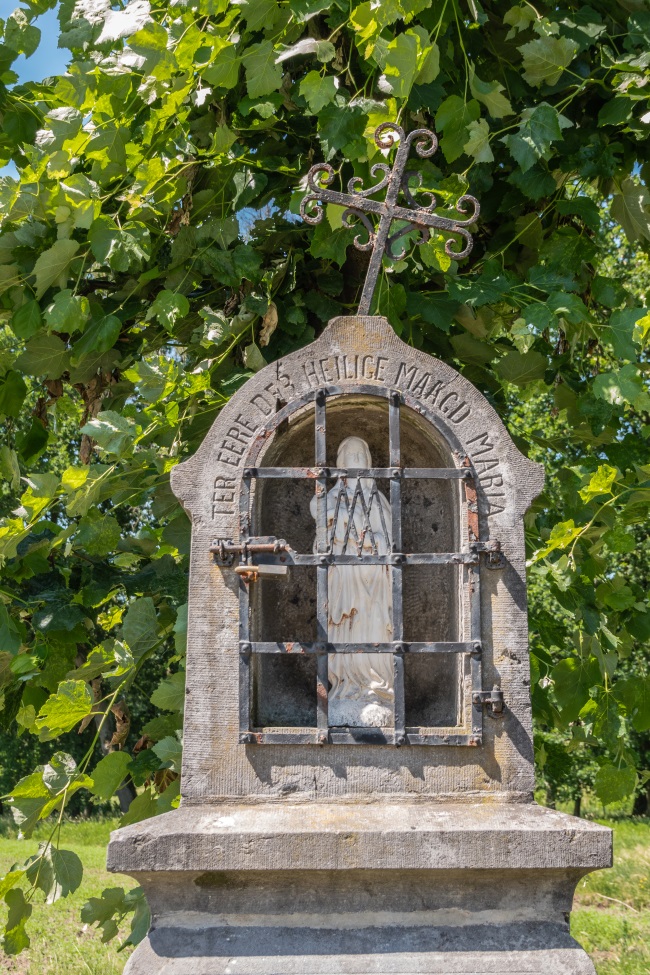In our latest Belgian religion article Martin Banks explores the fascinating phenomenon of religious shrines
You will almost have seen them as you cycle, walk or drive your way round Belgium. No, it’s not the proverbial frites vans that are still evident around the country, but something of a rather more cerebral nature.
Small, roadside religious shrines, or small chapels, can be found just about everywhere in Belgium – but can also be very easily overlooked.
If so, that is a shame for various reasons, not least of which is that they are often kept in absolute pristine condition, usually by a small team of willing local volunteers. These cosy chapels are often dedicated to a particular saint and have their roots firmly planted in the country’s traditional Catholic faith.
Passers-by might be puzzled by the small buildings, often located along countryside roads, and even mistake them for garden sheds. A closer inspection, however, reveals their purpose and also their charm.
Usually, the chapels are very small but there are also much larger, elaborate ones that even include pews and benches. They do not have any windows, but French inscriptions are sometimes found along with no end of religious statues, artwork and candles, all arranged with great and loving care.
These really are a place for religious artefacts, usually arranged in an asymmetric fashion. In larger shrines, a kneeling bench sits in front of the altar as a place for prayer.
The parish of Nivelles, south of Brussels, has no less than 120, including le Bon Dieu qui croquet, a typically beautiful little chapel featuring a cross and a selection of statues. Locals took advantage of the lockdown in 2020 to restore the chapel to its former state. The site/chapel itself is thought to have existed from as far back as the mid-19th century, as evidenced by an inscription on the crucifix.
The space, particularly small like most chapels, has one statue dedicated to St John, and another to Mary Magdalene. Behind them is a representation of the Virgin Mary installed during the 2020 renovation. This was probably donated by someone living locally, as is often the case with the religious memorabilia found in chapels across Belgium. But items such as flowers and candles, more likely than not, will be left by passers-by.
Other religious objects found in these chapels may come from old family graves, donated by families who would like such things to be kept in a “sacred” place.
Anne-Françoise de Beaudrap, of “Dimanche”, the Belgian Catholic newspaper, says that in other cases, items may have been left by someone who has lost a loved one or friend and does not know what to do with a religious object belonging to them. The chapel at le Bon Dieu qui croquet sits behind a secure metal gate which, while perhaps a sign of the times, at least helps protect the items on display.
Another one, located near the Prussian Monument on the outskirts of Waterloo, pays homage to St Rita (the saint of impossible causes) and is adorned with rosary beads. Patricia Eugene, who helps tend the site, including lighting the candles inside and ensuring there are fresh flowers, said, “It’s a sort of homage if you like.”
In most cases, it is almost impossible to find out why a chapel is located in any particular spot. Usually they are in the countryside, but a few are scattered around multi-cultural, urban Brussels. But Bernard Bracke, a priest based in Nivelles for over seven years, gives an insight into the background of these lovely, if curious, little roadside relics.
“People used to walk rather more in the past than they do nowadays and, as such, might need somewhere to not just rest or shelter a while but also say a prayer if they wished,” he says. “These chapels are nice whether you are a believer or not. For tourists, cyclists or people just out walking their dog they are a nice place to just stop and reflect.”

The chapels might be dedicated to a particular saint, commemorate a loved one or have been constructed as an expression of gratitude for a blessing received. Quite often there’ll be a reference to Lourdes, a major Catholic pilgrimage site.
As Bracke points out, these chapels rely very much on the goodwill of local people for keeping them in such pristine condition.
Brussels-based writer Derek Blyth says, “These tiny monuments dotted around the Belgian landscape are a reminder of a time when people navigated by wayside shrines and chapels, rather than satellite technology.”
Curiously, what appears to be a Belgian tradition has, over the years, also crossed the Atlantic, with similar sites popping up all over the United States, where even guided tours are organised.
The tradition for these sacred spaces was likely imported to the U.S. by Belgian settlers and immigrants who were devout Catholics. Chapels (in the U.S and here) are still seen as sacred spaces and a quiet reflection of the devout faith that the Belgian immigrants brought with them.
Traditionally, these wayside chapels were always ready to welcome any passers-by in search of a moment of quiet contemplation or prayer. Today, they continue to provide comfort and a quiet place to reflect which, given the pace of life today, is probably no bad thing.







